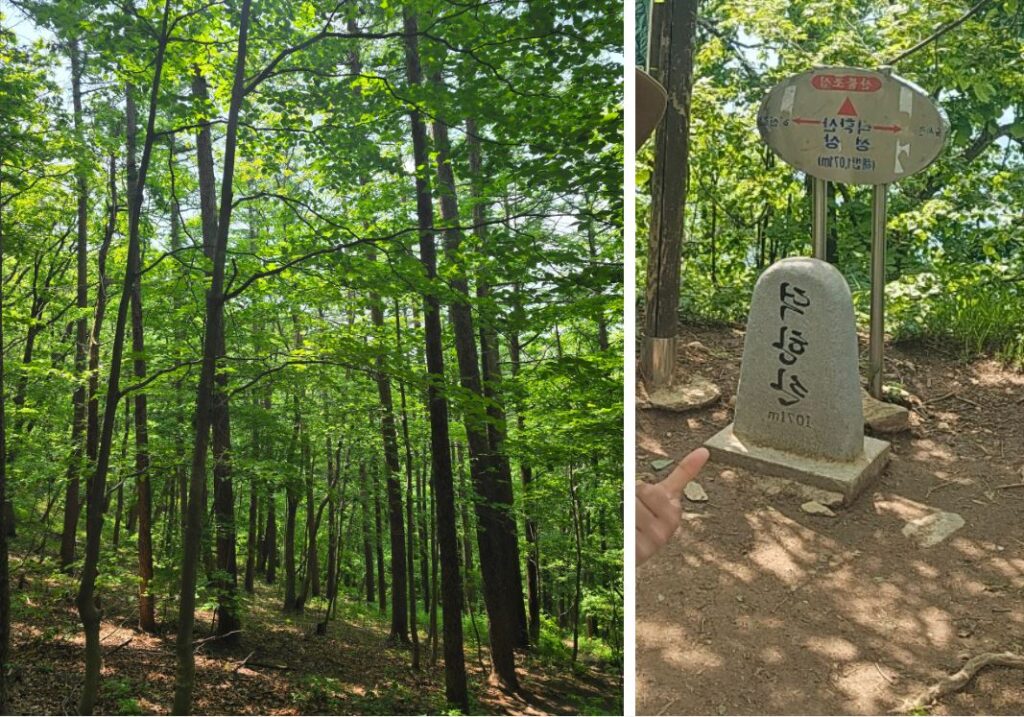In the bright, green month of May, I visited Deokhangsan Mountain, part of Korea’s Baekdudaegan range.
.
Passing through a quiet village and by a small church known as Jesus Abbey (Yesuwon), I began my hike.
.
At the entrance to the village, a sign asked visitors not to drive further up, so I parked by the bridge and started walking. Along the roadside, I noticed a swallow sitting on the ground—a rare sight, since they usually perch on power lines. Perhaps it had stopped to drink water.
.
While passing through Taebaek City and now here in Samcheok, I saw many fields filled with stones. I wondered what kind of crops grow here—perhaps Gangwon Province’s famous potatoes?
.

.
Jesus Abbey (예수원)
.
This is Jesus Abbey, founded by Father Richard Foster (known in Korean as Father Daechundeok).
The old, stately building left a strong impression.
.
I wanted to step inside for a moment, but since I was just a passerby, I decided to continue on toward Deokhangsan.
.

.
About ten minutes past the Abbey, I reached a fork in the trail.
There were no signposts, so I was unsure which way to go.
Fortunately, I had read blogs by hikers who had visited Deokhangsan before—they mentioned crossing a small wooden bridge to reach the trailhead.
.
Looking around, I found it—a slightly shaky bridge over a stream that made me hesitate before stepping on it.
Carefully crossing over stones and the creek, I continued upward.
If you plan to hike here, remember: you must cross the stream at the fork.
.

.
The trail up Deokhangsan is narrow but continuous, making it easy to stay on course.
The forest is so dense that to see the sky, you have to look straight up past the tall trees.
The area is a protected Baekdudaegan conservation zone, managed by the Korea Forest Service.
It is preserved as a model coniferous forest ecosystem.
.
For me, the best thing I could do was to leave no trash behind and simply enjoy the nature of Deokhangsan.
I hope all visitors will do the same—let’s keep our mountains clean.
.

.
Deokhangsan lies in the middle of the Baekdudaegan ridge, along the section between Daetjae and Geoneuiryeong, a total distance of about 19.7 km.
The full hiking route takes about 7 hours and 30 minutes and includes the following peaks:
.
Daetjae → Hwangjeongsan → Geunjae → Jaamjae → Jigaksan → Deokhangsan → Gubusiryeong → Geoneuiryeong.
.

.
This time, I only climbed Deokhangsan itself, but someday, I hope to continue along the entire Baekdudaegan trail.
Though there were a few challenging sections, the hike overall was peaceful and not too demanding—perfect for a moderate day’s hike.
.
.
.
About Deokhangsan (덕항산)
.
Deokhangsan (1,072.9 m) is located between Singimyeon and Hajangmyeon in Samcheok, Gangwon Province.
It is part of the Taebaek Mountain Range and forms a major watershed along the Baekdudaegan.
.
The mountain is home to Hwanseon Cave, a natural monument and one of the largest limestone caves in Asia, often called the “underground Geumgangsan.”
It lies within Daeiri County Park and is a designated natural monument area known for its impressive cave system.
.
Each peak of Deokhangsan has its own unique beauty, and the surrounding ridges create a stunning landscape of cliffs and rock formations known as Byeongpungam (Folding Screen Rock).
Traditional houses such as Neowajip (bark-roofed houses) and Gulpijip still remain in the nearby villages.
.
Deokhangsan is also listed among the Korea Forest Service’s Top 100 Wildflower Destinations, with many endemic and rare plant species.
It is an ecologically significant region marking the southern boundary of northern plant species, making it an important site for botanical research and conservation.

